Fisher Body Number Plate - 1972
[ Preface ] | [ 1964 ] | [ 1965 ] | [ 1966 ] | [ 1967 ] | [ 1968 ] | [ 1969 ] | [ 1970 ] | [ 1971 ] | [ 1972 ]
[ Arlington ] | [ Baltimore ] | [ Kansas City ] | [ Van Nuys/Los Angeles ] [ Oshawa ]
Introduction: For quite some time I’ve had an intense interest in Fisher Body Number plates, a.k.a. trim tag, cowl tag, firewall tag, etc. for 1964 through 1972 Chevelles - hereafter referred to as ‘trim tag’ since that seems to be most common moniker for these little jewels. Their diversity, not only between the different years but between the different plants in a given year, has always fascinated me. This page deals only with 1972 Chevelle trim tags.
The ninth model year of the Chevelle, 1972, saw its final assembly production occur at 4 plants in the U.S. - Arlington, Texas - Baltimore, Maryland - Kansas City, Missouri - and Van Nuys (or Los Angeles as some prefer) - plus Oshawa, Ontario, Canada.
I’ll not attempt to decode what each trim code, paint code, and where applicable, group option codes in this series represent. Click on any year's link in the navigation menu at the top of the page and choose the appropriate link on that year's home page where you’ll find links for detailed information for interior, paint, and group option codes.
All research to date indicates that each Fisher Body plant assigned body numbers in sequential order regardless of Fisher Body style numbers as they did in previous years. However, body numbers did not run sequentially from 000001 through some final production as they tended to do in earlier years. Whatever numbering system was used (and each plant's numbering system was unique to that plant), the reasoning is probably a result of the essential demise of Fisher Body as a separate entity within General Motors in 1968 when they were reorganized into the General Motors Assembly Division (GMAD) and many Fisher Body plant operations were absorbed.
The Fisher Body unit number has nothing to do with the vehicle identification number (VIN) assigned by GM at final assembly and if any were to match, it’d be a coincidence.
With that, let's begin 1972.
The 1972 Fisher Body Number plate for Arlington, contained only basic information and no frills. Arlington had no production reported in September, October, or November of 1969. According to GM News, the Monte Carlo was not built at the Arlington plant until 1972.
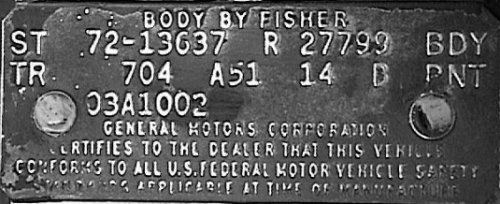
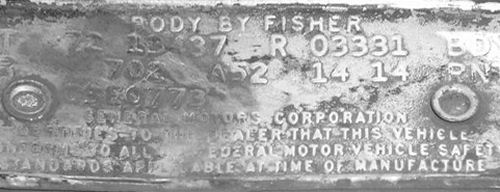
The first information line contains the abbreviation ST (for Style) followed by the model year (72), a hyphen, and the Fisher Body style number. Next is the designation for the plant location, R for Arlington, and the Fisher Body unit number followed by BDY. It should be noted that the Fisher Body style number (13637 for a Malibu sport coupe and 13437 for a Chevelle sport coupe in the examples) has nothing to do with the GM VIN series/model designation. That means the 13637 does not indicate a V8 engine just because the third digit is an even number. Fisher Body did not care if the car was to receive a V8 or L6 engine. Generally, the Fisher Body unit number, 27799 and 03331 in these cases, was sequential by body style number although it's not known what numbers were used to begin the sequencing.
The second information line contains the abbreviation TR (for Trim) followed by a 3-digit number indicating the seat color and material. Following blank spaces are codes A51 or A52. The 1972 model year began using a common trim code (such as 704) to indicate the color and material only, codes A51 and A52 denote whether the Chevelle was equipped with bucket (A51) or bench (A52) seats. Next is a pair of 2-digit numbers indicating the exterior paint color with the lower body color represented by the first pair and the upper body color represented by the second pair, and finally the word PNT. When the second pair is replaced by a single letter, this single letter indicates a vinyl or convertible top color.
I have no examples of special order paint Chevelle from Arlington for 1972. However, 1971 showed a blank space in the lower or upper positions as required. If a vinyl or convertible top was appropriate, a letter would be shown in the upper color position so it's assumed (but not yet proven) that 1972 would follow suit.
The third information line contains the body assembly date consisting of the month as a 2-digit number and a single letter (A…E) designating the week. When the month is a single digit month (January through September) the month number is padded with a leading zero (0) such as 01, 02, 03, etc. In the examples 03A is the 3rd month (March) and “A” represents the 1st week and 03E is the 3rd month (March) and "E" represents the 5th week.
Following the body assembly date code is a 3- or 4-digit data processing tracking number from the build sheet.
Baltimore differed from every other plant in 1972 in the respect they did not use the body number from the build sheet but rather a data processing number from block #24. Baltimore used a Fisher Body style that corresponded with the GM VIN series/model identification.
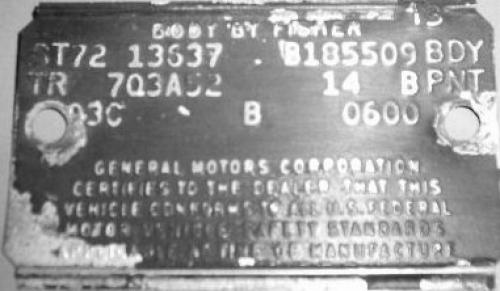
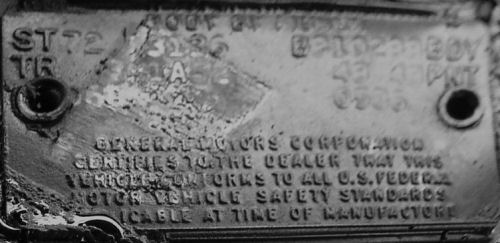
To the right of the embossed BODY BY FISHER is a 1- or 2-digit number but its meaning is unknown at this time.
The first information line contains the abbreviation ST (for Style) followed by the model year (72) and the Fisher Body style number. Next is the designation for the plant location, B for Baltimore, and the data processing number from block #24 of the build sheet followed by BDY. This data processing number does not appear to be sequential or follow any logical pattern.
Note the 13136 style number on the bottom tag. This indicates that Baltimore did use the same style number on the trim tag that would appear on the VIN; that is, this particular Nomad station wagon is an L6-engined Chevelle.
The second information line contains the abbreviation TR (for Trim) followed by a 3-digit number indicating the seat color and material. Next are codes A51 or A52. The 1972 model year began using a common trim code (such as 704) to indicate the color and material only, codes A51 and A52 denote whether the Chevelle was equipped with bucket (A51) or bench (A52) seats. Next is a pair of 2-digit numbers indicating the exterior paint color with the lower body color represented by the first pair and the upper body color represented by the second pair, and finally the word PNT. When the second pair is replaced by a single letter, this single letter indicates a vinyl or convertible top color.
Baltimore used dash characters for special paint in 1972.
The third information line contains the body assembly date consisting of the month as a 2-digit number and a single letter (A…E) designating the week. When the month is a single digit month (January through September) the month number is padded with a leading zero (0) such as 01, 02, 03, etc. Often the leading zero is obscured by the rivet on January through September trim tags.
Following the body assembly date are some letters (from none to 2) that are under research as to their meanings. The following are only conclusions drawn to date and not backed by any documented facts. These are believed to pertain to either interior or exterior (or maybe both) trim brightwork based on the body style by Fisher.
The letter(s) are listed along with series and body styles on trim
tags I currently have. If you have any 1970 Baltimore Chevelle trim
tags of any series not listed or tags of any series listed but with
different letters, please feel free to contact me with this information
via the Contact link in the navigation
bar.
No letters - 13136 Nomad station wagon, 13636 Concours station
wagon
B - 13637 Malibu sport coupe, 13680 Malibu El Camino, 13857 Monte Carlo
D - 13637 Malibu sport coupe
Following the letter above is a 4-digit data processing number found on the build sheet in block #24.


The first information line contains the abbreviation ST (for Style) followed by the model year (72) and the Fisher Body style number. Next is the designation for the plant location, K for Kansas City, a space, and the Fisher Body unit number followed by BDY. It should be noted that the Fisher Body style number (13637 for a Malibu sport coupe in the examples) has, to date, not been shown correspond with the GM VIN series/model designation for 1972 as it did for 1970 and 1971.
The second information line contains the abbreviation TR (for Trim) followed by a 3-digit number indicating the seat color and material. Next are codes A51 or A52. The 1972 model year began using a common trim code (such as 704) to indicate the color and material only, codes A51 and A52 denote whether the Chevelle was equipped with bucket (A51) or bench (A52) seats. Next is a pair of 2-digit numbers indicating the exterior paint color with the lower body color represented by the first pair and the upper body color represented by the second pair, and finally the word PNT. When the second pair is replaced by a single letter, this single letter indicates a vinyl or convertible top color.
Special order paint Chevelle from Kansas City showed a hyphen character in the lower or upper positions as required. If a vinyl or convertible top was appropriate, a letter would be shown in the upper color position.
The third information line contains the body assembly date consisting of the month as a 2-digit number and a single letter (A…E) designating the week. When the month is a single digit month (January through September) the month number is padded with a leading zero (0) such as 01, 02, 03, etc.
Following the body assembly date is a 5-digit number that is a data processing tracking number and is of no consequence today. The first 4 digits are found in block #24.
Next are some letters (from none to 1) that are under research as to their meanings. The following are only conclusions drawn to date and not backed by any documented facts. These are believed to pertain to either interior or exterior (or maybe both) trim brightwork based on the body style by Fisher.
It is further speculated that the letters "B" and "W" denote the optional hood & deck stripe color.
The letter(s) are listed along with series and body styles on trim
tags I currently have. If you have any 1972 Kansas City Chevelle trim
tags of any series not listed or tags of any series listed but with
different letters, please feel free to contact me with this information
via the Contact link in the navigation
bar.
No letters - 13637 Malibu sport coupe, 13667 Malibu convertible, 13680
Malibu El Camino, 13857 Monte Carlo
L - 13637 Malibu sport coupe, 13667 Malibu convertible, 13680 Malibu
El Camino
L B - 13637 Malibu sport coupe, 13667 Malibu convertible
L W - 13637 Malibu sport coupe
Van Nuys/Los Angeles California
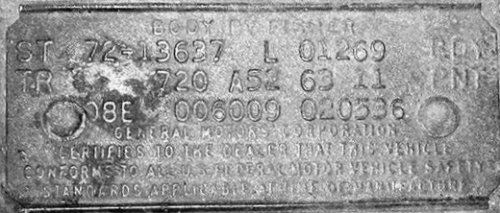
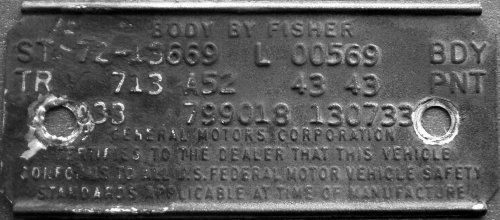
The first information line contains the abbreviation ST (for Style) followed by the model year (72), a hyphen, and the Fisher Body style number. Next is the designation for the plant location, L for Van Nuys, a space, and the Fisher Body unit number.
The second information line contains the abbreviation TR (for Trim) followed by a 3-digit number indicating the seat color and material. Next are codes A51 or A52. The 1972 model year began using a common trim code (such as 704) to indicate the color and material only, codes A51 and A52 denote whether the Chevelle was equipped with bucket (A51) or bench (A52) seats. Next is a pair of 2-digit numbers indicating the exterior paint color with the lower body color represented by the first pair and the upper body color represented by the second pair, and finally the word PNT. When the second pair is replaced by a single letter, this single letter indicates a vinyl or convertible top color.
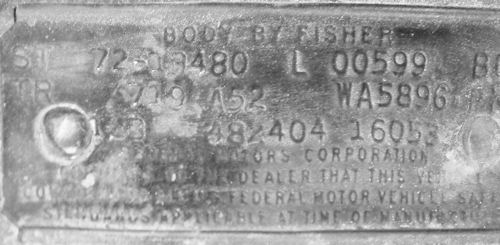

To date, two special order paint trim tags (a 13480 Chevelle El Camino and a 13236 Nomad station wagon) have been found for 1972 and both are apparently state fleet cars (reportedly orange) so it's unsure if a customer ordered special paint code would be depicted in the same format.
The third information line contains the body assembly date consisting of the month as a 2-digit number and a single letter (A…E) designating the week. When the month is a single digit month (January through September) the month number is padded with a leading zero (0) such as 01, 02, 03, etc. In the examples 08E is the 8th month (August) and “E” represents the 5th week and 03B is the 3rd month (March) and "B" represents the 2nd week.
Next are two sets of 6-digit numbers. The first 6-digit number is a data processing number found in block #24 of the build sheet. The second 6-digit number is a concatenation of a 2-digit (from block #10) and a 4-digit (from block #24)data processing numbers also found on the build sheet. They do not depict option codes or the like so their significance today is of no consequence. They are handy to match a car's trim tag to any build sheet that may be found in the car as these numbers should appear in the respective blocks on the build sheet.
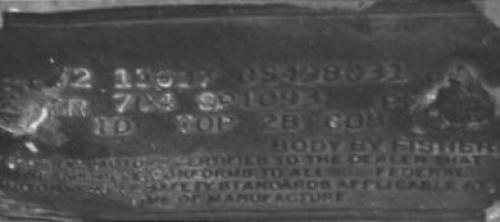
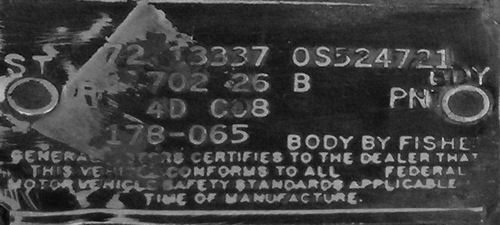
The first information line contains the abbreviation ST (for Style) followed by the model year (72), a space, and the Fisher Body style number. Next is the designation for the plant location, OS for Oshawa, and a data processing number that appears to be sequential regardless of the style number.
The second information line contains the abbreviation TR (for Trim) followed by a 3-digit number indicating the seat color and material. Oshawa did not note the seat type (A51 or A52) so there is no real way to tell from the trim tag if bucket (A51) or bench (A52) seats were installed. Next is a pair of 2-digit numbers indicating the exterior paint color with the lower body color represented by the first pair and the upper body color represented by the second pair, and finally the word PNT. When the second pair is replaced by a single letter, this single letter indicates a vinyl or convertible top color except in the case of special order paint.
In the case of special order paint the paint code area will show SP and a 4-digit number. Whether this 4-digit number is a paint code for a specific color or not is not known. If a vinyl top, the top color is shown on the third information line such as TOP 2B in the first example.
The third information lines contain the body assembly date consisting of the month as a 1- or 2-digit number and a single letter (A…E) designating the week. When the month is a single digit month (January through September) the month number is not padded with a leading zero (0) such as 1, 2, 3, etc. In the examples 1D is the 1st month (January) and “D" represents the 4th week and 4D is the 4th month (April) and "D" represents the 4th week.
Sometime between 1D and 4D a fourth line of information was added consisting of two 3-digit numbers separated by a hyphen character. The significance or the origin of this set is unknown.

 Home
Home Decode
Decode Tech
Tech Tools
Tools Dale's Coins/CDs
Dale's Coins/CDs Contact
Contact Chevelle
of the Month
Chevelle
of the Month Things
For Sale
Things
For Sale Custom
Stickers
Custom
Stickers